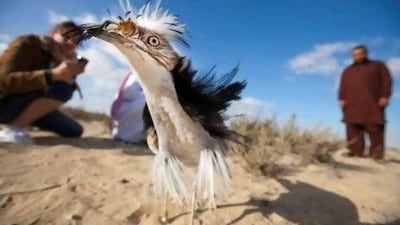ABU DHABI // The humans gathered to release about 85 houbara bustards into the early morning skies were much more excited about the prospect than the birds.
The houbara sat quietly in their cages, not knowing that their life-long captivity was about to end.
On Sunday evening, the bustards were caught and placed in the large plastic cages. Before daybreak yesterday, they were loaded on to pickup trucks and left the National Avian Research Centre (Narc) in Sweihan, near Al Ain.
They had been born at the centre through artificial insemination and raised until they were nine months old.
As the sun was about to rise yesterday, the cages were lined up in a row at the birds’ new home, the location of which has been kept secret as the houbara was once hunted to near extinction.
The early hour was chosen to help them settle, said Mark Lawrence, the project coordinator at Narc.
“It gives them the whole day to start establishing themselves in their new home,” Mr Lawrence said.
Their release, an initiative by the International Fund for Houbara Conservation in Abu Dhabi, is an attempt to restore wild populations.
More than 1,000 birds have been released into the wild already this season. Between 2003 and last year, the number had reached 3,188.
The ecologist Pierrick Rautureau started proceedings yesterday, opening the first box, taking out the birds one at a time and placing them gently on the ground.
“If they start trying to fly while still in the crate they can break their wings or legs,” Mr Rautureau explained.
Several men followed his example, including Mr Lawrence and Ahmed Al Mansouri, the head of rangers at the Environment Agency – Abu Dhabi, the Government body that manages protected areas.
The birds walked away slowly but steadily, exploring the desert terrain by constantly turning their heads from side to side. After a few minutes, one houbara decided to try flying, and several followed.
“We spend a lot of time with the birds in the cages. It is always nice to see them in their natural habitat,” said Mr Lawrence as he watched them soar off.
But most of the birds preferred to survey the area on foot. Within minutes they disappeared from view, their sandy-coloured plumage providing the perfect desert camouflage.
Even though the birds were now in the wild, they would continue to be under the watchful eyes of the scientists.
“The job starts from here to know how they establish and how they survive so we can improve our [release] technique in future,” Mr Lawrence said.
Every bird released by the programme had two rings, each bearing its unique identification number.
Thirty-five of the houbara were also fitted with satellite or radio transmitters, giving the team information about their movements.
The houbara bustard is a migratory bird but some populations stay at one location all year. The released birds are expected to stay in the UAE.
Once they find their bearings in the protected area, some may venture outside of it, which could place them at risk from poachers and hunters.
Mr Al Mansouri said that while hunting was a very important tradition, some forms of the sport harmed the environment.
“In the past, people were hunting to eat; they were using falcons and did not kill houbara in big numbers,” he said.
In more recent years, hunters started using cars and shotguns, and killed the birds for sport.
But awareness about the importance of protecting the houbara bustard has increased, Mr Al Mansouri said.

